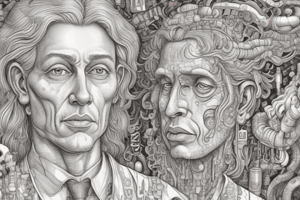Podcast
Questions and Answers
Which of the following manuals are used to diagnose mental illness?
Which of the following manuals are used to diagnose mental illness?
- The Psychiatric Evaluation Manual
- The Diagnostic & Statistical Manual of Mental Disorders (DSM) (correct)
- The International Classification Of Diseases (ICD) (correct)
- The Mental Health Assessment Tools
What is classification?
What is classification?
Identifying clusters of symptoms, putting them into categories, and classifying the disorder as part of a wider class of disorders.
Match Schneider's symptoms with their descriptions:
Match Schneider's symptoms with their descriptions:
Passivity experiences and thought disorders = Thoughts and actions perceived as under external control Auditory hallucinations = Voices in their heads discussing the sufferer's behavior Primary delusions = Believing they are very important, such as Jesus reborn
What is psychopathology?
What is psychopathology?
Define psychosis.
Define psychosis.
What is neurosis?
What is neurosis?
What is aetiology?
What is aetiology?
What characterizes Type I schizophrenia?
What characterizes Type I schizophrenia?
What characterizes Type II schizophrenia?
What characterizes Type II schizophrenia?
What are negative symptoms?
What are negative symptoms?
Provide examples of negative symptoms.
Provide examples of negative symptoms.
What is speech poverty?
What is speech poverty?
What are positive symptoms?
What are positive symptoms?
Provide examples of positive symptoms.
Provide examples of positive symptoms.
What are hallucinations?
What are hallucinations?
What are delusions?
What are delusions?
What are Slater & Roth's symptoms?
What are Slater & Roth's symptoms?
What classification systems are commonly used for schizophrenia?
What classification systems are commonly used for schizophrenia?
Define reliability in the context of diagnosis.
Define reliability in the context of diagnosis.
What are the types of reliability?
What are the types of reliability?
What is positive predictive value (PPV)?
What is positive predictive value (PPV)?
Flashcards are hidden until you start studying
Study Notes
Classification of Schizophrenia
- Diagnostics primarily rely on two manuals: DSM (Diagnostic & Statistical Manual of Mental Disorders) and ICD (International Classification of Diseases).
- DSM developed by the American Psychiatric Association; ICD by the World Health Organization.
What is Classification
- Involves clustering symptoms and categorizing them.
- Aims to classify the disorder within a broader group of mental health disorders.
Schneider's (1959) Symptoms
- Passivity experiences: Perception of thoughts/actions being externally controlled.
- Auditory hallucinations: Hearing violent voices commenting on the individual's behavior.
- Primary delusions: False beliefs in high importance, such as being a religious figure.
Psychopathology
- The study focused on mental diseases.
Psychosis
- Severe mental disorder characterized by significant emotional and mental disruptions.
- More debilitating than neurosis.
Neurosis
- Also referred to as chronic; it is a mild mental disorder not stemming from organic diseases.
- Often linked to stress, anxiety, and depression.
Aetiology
- The examination of origins and causes of mental disorders.
Type I Schizophrenia
- Acute form with positive symptoms; typically responsive to medication.
Type II Schizophrenia
- Chronic type characterized by negative symptoms; usually resistant to medication.
Negative Symptoms
- Include emotional disruptions and dysfunctional behaviors.
- Common in chronic episodes, leading to difficulties in social functioning.
Examples of Negative Symptoms
- Affective deficits: Lack of emotional expression.
- Communication deficits: Variable speech patterns.
- Avolition: Reduced motivation.
- Social withdrawal and poor personal hygiene.
- Catatonia: Lack of movement.
Speech Poverty
- Recognized as a negative symptom by ICD-10; involves limited speech output.
Positive Symptoms
- Represent loss of reality touch, including hallucinations and delusions.
- Typically occur in acute episodes and are responsive to medication.
Examples of Positive Symptoms
- Hallucinations and delusions.
- Echolalia: Repetition of another's speech.
- Psychomotor agitation and incoherent speech.
Hallucinations
- False perceptions of non-existent stimuli.
Delusions
- Strongly held false beliefs not aligned with reality.
Slater & Roth's (1969) Symptoms
- Thought process disorders: Includes speech poverty and unusual language use.
- Disturbances of effect: Inappropriate responses to situations.
- Psychomotor disturbances: Involvement in tics or repetitive behaviors.
- Avolition: Lack of decision-making and low energy.
Diagnosis of Schizophrenia
- Diagnosed through DSM-5 or ICD-10 systems; distinct symptoms allow reliable diagnosis.
Reliability
- Refers to consistency in diagnosing schizophrenia among clinicians.
- Test-retest reliability: Evaluation of consistency across multiple assessments.
- Inter-rater reliability: Agreement between different clinicians diagnosing a patient.
Positive Predictive Value (PPV) & Cohen's Kappa
- Measures of reliability evaluating consistency of diagnoses over time.
- PPV reflects the proportion of patients retaining the same diagnosis, usually expressed in percentages.
Studying That Suits You
Use AI to generate personalized quizzes and flashcards to suit your learning preferences.




